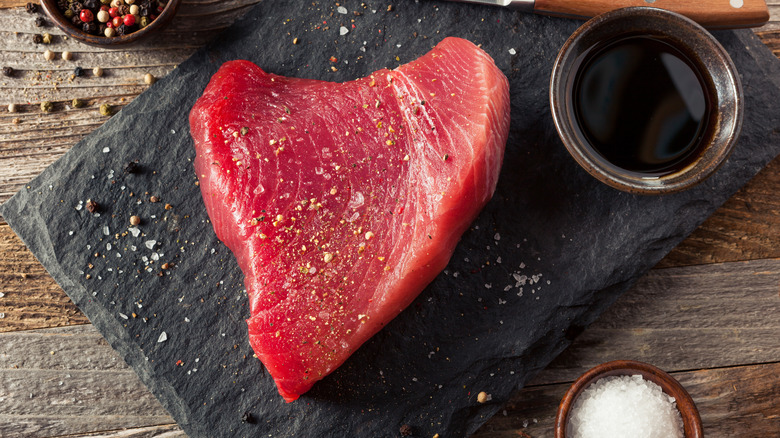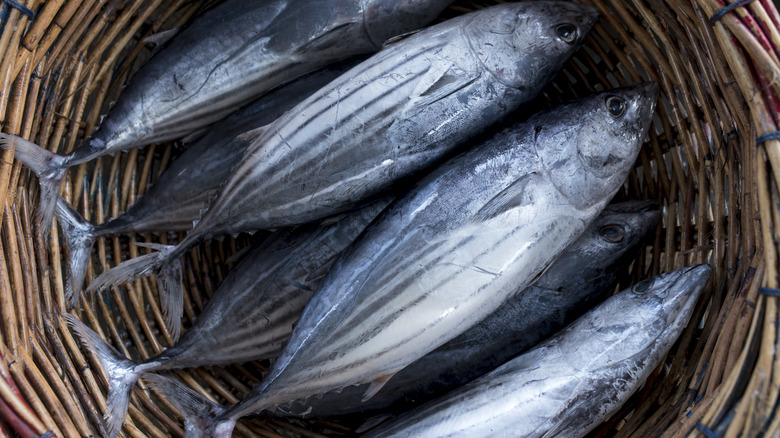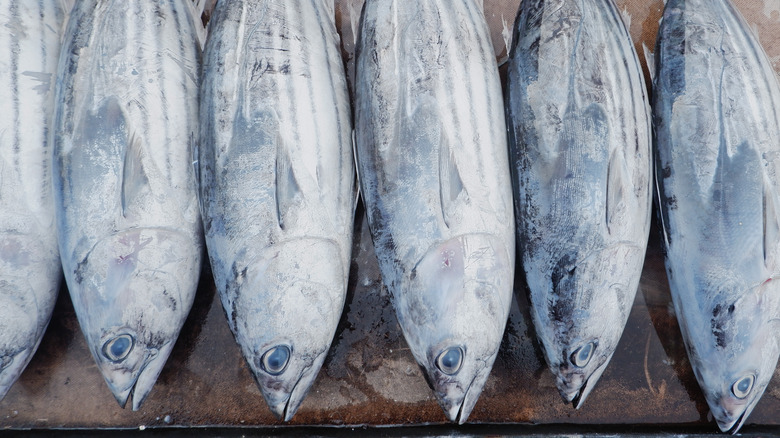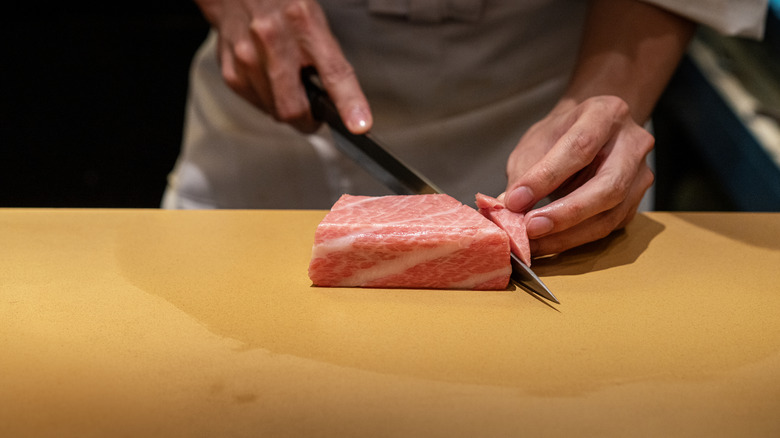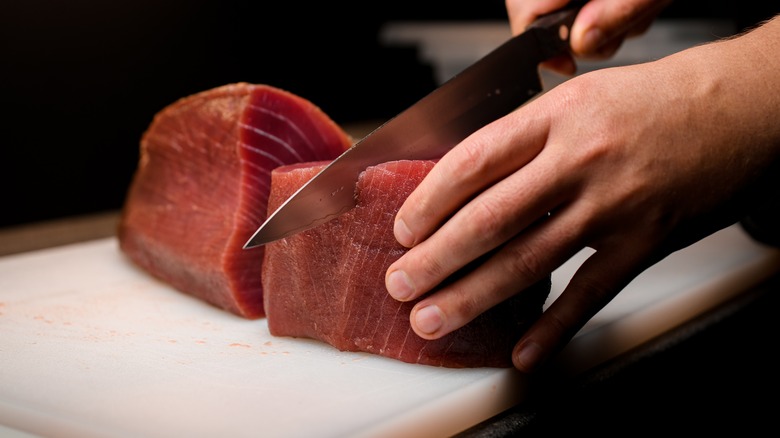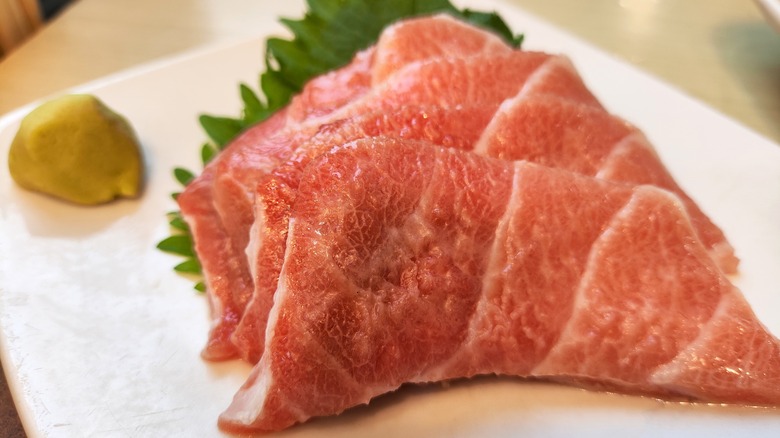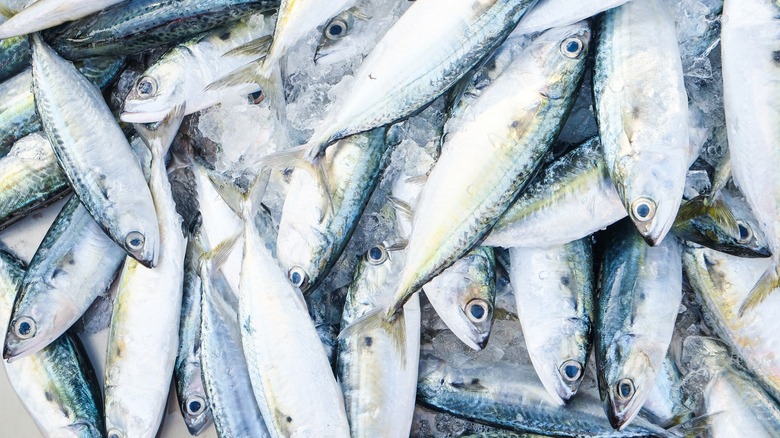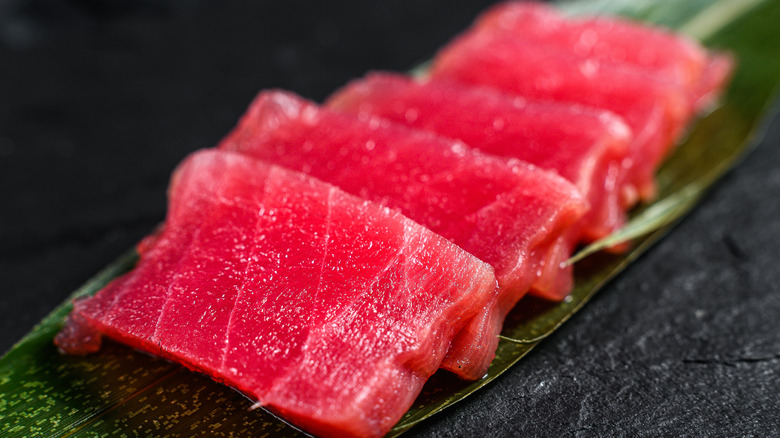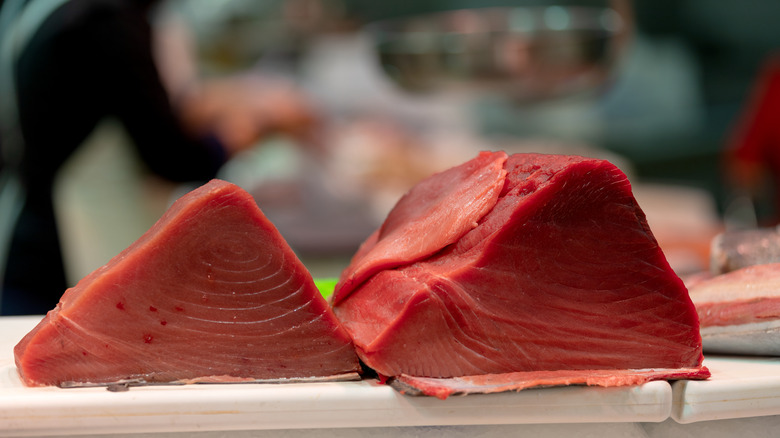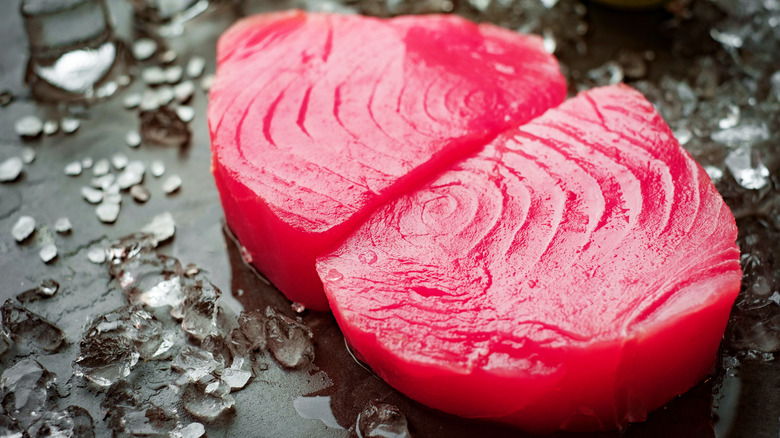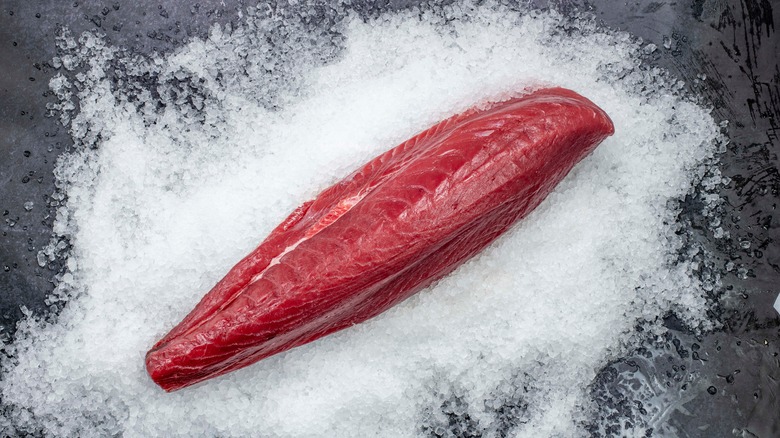The Ultimate Guide To Buying Fresh Tuna
Next time you have a hankering for tuna, skip the canned stuff. Buying fresh tuna can seem pretty daunting, particularly if you're not used to purchasing seafood. However, there are loads of reasons to love it. Fresh tuna is an excellent entry point for fresh seafood, thanks to its meaty taste, versatility, and the relative ease of its preparation and cooking. You can tuck fresh tuna into a sandwich, make delicious soy grilled tuna steaks, eat it as sashimi, or lay it daintily over potatoes or pasta — it's delicious every time. Fresh tuna is also surprisingly affordable while still feeling like a real treat, and when bought sustainably it's an ethically sound choice.
However, buying fresh tuna is far from simple. A lot of people don't know where to start with the seafood, and which cuts to opt for or how to tell if it's fresh. Additionally, many folks don't know the underbelly of the fishing industry well enough to make assured choices about sustainably-sourced food. We knew we needed to ask an expert's help, so we hit up Jimmy Ulcickas, the co-owner and co-founder of the Bluewater Grill family of seafood restaurants in the West. Ulcickas has been sourcing, preparing, and serving the best tuna for 30 years. We used his advice as a jumping-off point for deciding the key points to include in this article, and focused on information that novices need to know and seasoned pros would do well to be reminded of.
Everything starts with the type of tuna you choose
As with many different types of meat and seafood, there's not just one type of tuna. Rather, the fish comes in several different varieties, and all of them have a subtly different taste, appearance, and use. Bluefin and Ahi tuna are the two most likely types you'll find in fresh form. Bluefin comes from the Atlantic, Pacific, and Southern regions, and it's the largest tuna variety out there. It's the type you're most likely to find in fancy seafood and sushi restaurants, thanks to its deep, rich flavor that almost tastes like steak, higher fat content, and vibrant color. Southern Bluefin is especially well-prized, and the belly (or Otori) cut represents the ultimate in fresh tuna.
Ahi tuna, meanwhile, can be split into two different types: Yellowfin and Bigeye. Ahi tuna tends to be leaner than Bluefin and tastes less meaty and succulent, and is lighter and almost zestier. Its color is also lighter; instead of the deep red appearance of Bluefin, it has a pinkish tone. Ahi tuna tends to be cheaper than Bluefin, and is therefore more common in mid-range restaurants — and may also be easier to find from your local fishmonger.
Your location may determine how fresh it is
Unless you have the good fortune of living right next to the coast, it's likely that your seafood had to travel to get to you. When it comes to tuna, however, that can affect the type you buy. Like all fish, fresh tuna can start to spoil quickly, and if you live inland, it's likely that it's traveled over several days to get to your store. Some suppliers try to get around this by freezing and then thawing their tuna once it arrives in-store, but this can deteriorate its quality. In the worst case scenario, the "fresh" tuna you're buying may be hours away from turning bad.
If you live in a coastal location where tuna fisheries operate, this shouldn't be too much of an issue — but inlanders may have to get wise to the warning signs of tuna that's going bad. Watch out for any unpleasant smells or slimy textures on the meat. You should also keep an eye on where your tuna was fished: If it's from an American fishery, it will logically have traveled fewer miles than if it was caught further afield. Don't be afraid of buying frozen tuna, either. While it may not seem like the best option, frozen tuna is considered just as high-quality as the fresh stuff.
When selecting tuna, look at its marbling
When buying chicken, beef, or pork, most people know that opting for fattier cuts will give you more flavor and tenderness. The same goes for tuna, too. "It all comes down to the combination and proportion of lean and fatty meat," says Jimmy Ulcickas. "Tuna is similar to most other animal protein: The fattier and more marbled the meat, the richer the taste and the more it melts in your mouth."
Ulcickas points out that different cuts of tuna will have different flavors and textures, largely due to the varying fat levels in distinct parts of the fish. The fattier, juicier cuts will usually have a higher price point, whereas leaner, more delicately-flavored parts will be on the cheaper side. It can be difficult to properly assess marbling when you're buying your fish pre-packaged in a supermarket, which is another reason why going to a fishmonger or fish market is best when purchasing fresh tuna. In these settings, you'll be able to have a proper conversation with an informed individual about the fish you're buying, and they'll be able to advise you on which cuts have the best marbling.
Sustainably-sourced tuna is the best option
Sustainability is a huge issue when it comes to seafood, and especially with tuna. More than half of the tuna most commonly fished for commercial purposes worldwide is thought to be unsustainable, according to Seafood Watch. These unsustainable types don't just come from specific parts in oceans, but in full oceans themselves: All tuna caught in the Indian Ocean, for example, is considered unsustainable.
So, if you want to make an ethically-minded choice, Jimmy Ulcickas says that you'll have to get talking. "It is often difficult to tell by the fish itself so I'd recommend you ask your supplier if you are in the restaurant business or your fishmonger or server if you are in a fish market or restaurant. They are obligated to know if their fish was sustainably harvested," Ulcickas advises. He points out that certification from reputable organizations like California's Monterey Bay Aquarium is the clearest sign that your fish has been caught with sustainability in mind. It's worth bearing in mind, too, that some popular types of fresh tuna, like Bluefin, are considered unsustainable by major bodies like Seafood Watch. As such, just because a type of fresh tuna is considered gourmet or desirable, it doesn't make it totally ethical.
Different cuts of tuna have different uses
Completely baffled by which cut of fresh tuna to choose? Don't worry, we've got you. Jimmy Ulcickas tells us that there are several key cuts that are used in some key applications. The first cut is "akami," which is "the lean meat from the sides of the fish," says Ulcickas. "It's the most common cut and is usually used for sushi and sashimi. It has a deep red color and a firm texture and can be cut into triangular steaks."
The next cut, "toro," is a luxurious choice. Coming from the fatty belly of the fish, Ulcickas states that it has a buttery texture and a certain richness that makes it stand out from other parts. Toro can be broken down into two subsections, "chutoro" and "otorio," with the latter being the fattiest, most expensive part. Chutoro is slightly leaner and a good choice for those on a budget who still want to enjoy some luxury.
"'Saku blok' is another key cut. These are rectangular blocks cut from the loin, typically used for sashimi or sushi. They are convenient for slicing into pieces," says Ulcickas. The final cut, the loin, is great for grilling and can be used for sashimi.
Learning how to check if your tuna is fresh is crucial
No one wants to buy fish that's past its prime, when it comes to fresh tuna, that can be surprisingly easy to do. That's why you need to get familiar with its warning signs, with the first being its appearance. "Fresh tuna should have a deep red color, depending on the variety. It should look moist and shiny, not dry or dull," says Jimmy Ulcickas. "Avoid tuna with brown spots or discoloration." Ulcickas also states that your tuna's texture "should be firm to the touch and bounce back when pressed," and should not feel soft or slimy. If you can't get your hands on it in the fish market, ask the person you're buying it from to do a touch test so you can assess it from afar.
Next, take a look into its eyes — we know, we know, it's not fun, but it's crucial. "If you're buying whole tuna, the eyes should be clear and bright, not cloudy or sunken." Finally, you need to take a look at its bloodline. This is the dark portion of the meat and its color is a key clue to the fish's freshness. "This should be bright red. If it's brown or dark, the fish is not fresh or it was previously frozen," Ulcickas says.
Watch out for treated tuna
One of the biggest appeals of fresh tuna is its vibrant red color. Whether it's a cut that you can use for a perfectly-seared steak, or sliced into delicate sashimi slices, this deep red hue can give the appearance of healthiness and better flavor. However, this red tone is often a result of it being treated with carbon monoxide, which helps to preserve its color. Unfortunately, this same process doesn't make the fish keep for longer — and as a result, what can happen is that you're eating tuna that looks fresh, but that is actually past its prime or even spoiled.
Therefore, you should never judge a book by its cover when it comes to fresh tuna. The fish naturally changes color once it's been sliced, and turns from a deep red to a darker uniform brown (remember that brown spots are not a good sign though). Although this may not look as visually appealing as the bright red tone we know and love, it doesn't make any difference to the fish's quality or flavor. Additionally, when it's left untreated you're more likely to get a good sense of when it goes bad, and so you can avoid serving your guests tuna that's not up to scratch.
A big mistake when buying tuna is forgetting to smell it
One of the best senses we have to assess whether our food is fresh is our smell — and yet, it's so easy to just judge what we're buying by sight. With fresh tuna, that isn't an option. You might be surprised by the smell you should be looking for when it comes to this cut, too. "The most common (and understandable) misperception is that fresh fish should smell fishy. A fresh piece of tuna should smell more like the ocean," says Jimmy Ulcickas. Fishy-smelling tuna is actually a sign that it's getting older and could be on the way to spoiling.
Luckily, Ulcickas has some excellent tips for us, based on his practical experience. "As a fisherman, a good rule of thumb for me is if the fish smells pleasant, it is likely fresh. If it is offensive or smells like ammonia, it is past its prime," he says. It's also important not to get scared of getting your nose right up against your fish. If you're buying it in a fish market, it's probably a pretty pungent setting, and you don't want to mistake the general smell of fish in the air for the tuna you're buying.
Fresh tuna can have higher mercury levels
The mercury content of tuna is often the elephant in the room with this fish. Tuna is rich in protein, high in vitamin and mineral content, and has a great amount of healthy omega-3 fatty acids – and yet, its high mercury levels mean that you can't eat too much of it. Unfortunately, when it comes to fresh tuna, you need to be on your guard even more as it can often have far more mercury than canned tuna. This is because the tuna most commonly used for canned versions are smaller and don't have as much time to accumulate mercury. Fresh tuna, on the other hand, comes from larger fish. Incidentally, some chefs think that canned tuna is tastier than fresh, but that's not down to the mercury — that's just a preference.
The thing about mercury poisoning, too, is that it can creep up on you. Just as it builds up in tuna, it also builds up in your body. When it reaches dangerous levels it can start producing symptoms like numbness and tremors, and in more profound situations it can lead to brain and kidney damage, according to a study in the Journal of Neuroscience Research. You should limit eating tuna to a maximum of three times a week, as noted by Healthline but if you're eating particularly big portions it's best to consume it less often.
If you're buying tuna to prepare and eat raw, look for sushi-grade tuna
Tuna is highly prized in sushi and sashimi, and it's one of those fishes that even novices feel comfortable preparing raw. However, if you're doing so, you'll want to make sure you're looking for the right type. It's best to use sushi-grade tuna when purchasing it to eat raw. Knowing whether or not your tuna is sushi-grade can be tricky, but it will generally be better quality and fresher, and therefore more capable of being eaten raw.
However, that's not always the case. The issue with buying "sushi-grade" tuna is that the term is unregulated, and therefore food manufacturers are technically not obliged to follow any specific practices when selling it. That's why you need to be seriously savvy when it comes to how the fish looks, feels, and smells when buying it to ensure maximum freshness. You should also be willing to ask questions. If you're buying the tuna in a fish market, make sure you ask the vendor how they determine whether tuna is "sushi grade," what conditions the fish has been kept in and at what temperature, and how long it's been in the store. If there's any ambiguity or lack of trust, purchase it elsewhere.
Be aware of the warning signs that could indicate your tuna is fake
Is that actually tuna you're buying, or another fish entirely? The answer may surprise you. One of the biggest issues when it comes to buying fresh tuna is assessing whether it's actually real, due to how commonly it's mislabeled. An investigation conducted by Oceana between 2010 and 2012 looked into the widespread problem of fish fraud and how common it is for fish to be mislabeled as tuna. It found that almost 60% of all tuna samples found in almost 700 retail outlets weren't what they said they were. In these situations, escolar was commonly labeled as "white tuna," which is pretty worrying, considering that "white tuna" doesn't actually technically exist.
So, how can you tell if your tuna is fake? You have three key tools in your arsenal: Price, color, and tracing. Tuna doesn't cost the world, but it's by no means a cheap fish. If the tuna you're buying is set at a bargain price, it could be the case that it isn't what it says it is. Tuna's natural tone is also a big giveaway: The fish is most commonly a red-brown color when fresh, and if it's looking pale or milky, it might be something else. Finally, your fish vendor should be able to tell you where the fish has come from. If they can't, there may be some ambiguity around its origins.
